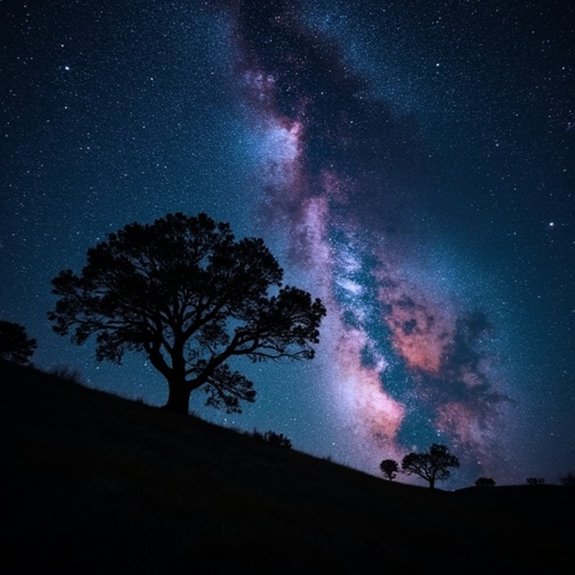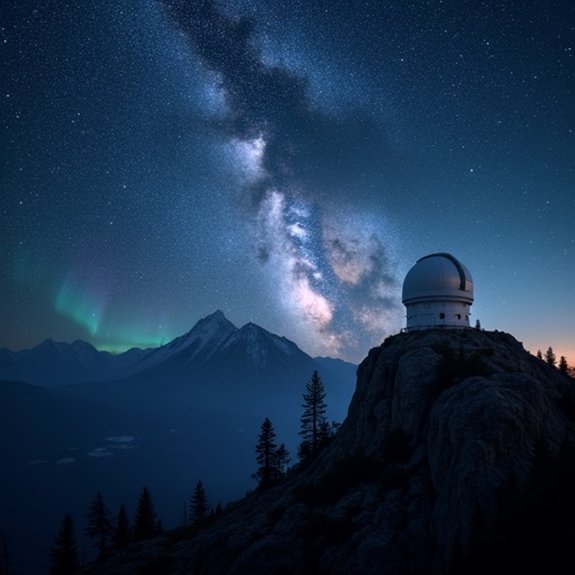The Celestial River: Milky Way Myths
Throughout history, civilizations haven’t just observed the Milky Way—they’ve woven it into their cultural DNA. Ancient peoples transformed this luminous band into rivers, pathways, and divine messages that shaped their understanding of existence. While Chinese lovers yearned across its starry divide and Greeks saw Hera’s spilled milk, other cultures harbored even stranger explanations. The Egyptian interpretation proves particularly fascinating, revealing how one civilization’s sky goddess forever changed astronomical mythology.
Introduction

When ancient civilizations gazed up at the night sky, they couldn’t help but notice the luminous band of light stretching across the darkness—what we now call the Milky Way. This celestial river has captivated humanity for millennia, inspiring countless myths and legends across diverse cultures. From the Greeks who saw it as divine milk spilled by Hera to the Chinese who envisioned it as a silver river separating two star-crossed lovers, each society’s created unique narratives to explain this cosmic phenomenon.
These stories weren’t mere entertainment; they’ve served as navigation tools, agricultural calendars, and moral teachings. Today’s astronomers understand the Milky Way as our galaxy’s dense collection of stars, but the ancient myths remain powerful reminders of humanity’s enduring quest to comprehend the universe.
Ancient Egyptian Sky Goddess Myths
As the sun set beyond the western horizon, ancient Egyptians believed they were witnessing the sky goddess Nut swallowing the solar disk, only to give birth to it again at dawn. They’d observe the Milky Way stretching across Nut’s star-covered body, interpreting it as her backbone or the path along which souls traveled to the afterlife.
In their cosmology, Nut’s arched form created the vault of heaven, with her fingertips and toes touching Earth’s edges. The goddess’s body separated the ordered world from primordial chaos. Priests taught that the Milky Way’s luminous band represented milk flowing from Nut’s breasts, nourishing the pharaoh and ensuring cosmic balance. This celestial river also served as a divine waterway where Ra’s solar barque sailed nightly through the underworld.
Notable Cases or Sightings

Astronomers throughout history have documented striking observations of the Milky Way that shaped humanity’s understanding of the cosmos. In 1609, Galileo’s telescope revealed the galaxy’s true nature as countless individual stars rather than celestial mist. His sketches transformed how people viewed the night sky’s bright band.
Ancient Chinese astronomers recorded the Milky Way’s seasonal movements as early as 400 BCE, calling it the “Silver River.” They’ve tracked its position changes and brightness variations in detailed star maps that modern scientists still reference.
Indigenous Australian groups documented the “Emu in the Sky” for over 40,000 years, using dark dust lanes in the Milky Way for seasonal calendars. The Inca similarly observed these dark patches, identifying them as llamas drinking from the celestial river.
Common Theories or Explanations
These documented observations sparked countless attempts to explain what the Milky Way actually was. Ancient Greeks believed it was breast milk from the goddess Hera, spilled across the heavens when she’d pushed away the infant Heracles. Norse mythology described it as the path to Valhalla, where fallen warriors traveled to reach their eternal home.
Eastern cultures offered different interpretations. Chinese astronomers called it the “Silver River,” separating two star-crossed lovers who could meet only once yearly. Hindu texts identified it as the Ganges River’s celestial counterpart, flowing through the heavens.
Native American tribes developed their own theories. The Lakota saw it as the trail souls followed after death. The Cherokee believed it was cornmeal scattered by a dog who’d stolen it from Earth.
Frequently Asked Questions
How Do Different Native American Tribes Interpret the Milky Way in Their Stories?
Native American tribes interpret the Milky Way diversely – Cherokee see it as cornmeal scattered by a dog, Lakota view it as spirits’ trail to the afterlife, while Pueblo peoples consider it a path between worlds.
What Role Does the Milky Way Play in Chinese Mythology and Folklore?
In Chinese mythology, the Milky Way’s called the “Silver River” that separates two star-crossed lovers—the weaver girl Zhinü and cowherd Niulang. They’re allowed to meet just once yearly when magpies form a bridge across it.
How Did Ancient Greek and Roman Cultures Explain the Milky Way’s Origin?
Ancient Greeks and Romans believed the Milky Way formed from Hera’s spilled breast milk when she pushed away baby Heracles. They’ve also described it as a pathway to Mount Olympus where gods resided.
What Are the Aboriginal Australian Dreamtime Stories About the Milky Way?
Aboriginal Australian Dreamtime stories depict the Milky Way as a river where ancestral spirits travel, campfire smoke from the sky people, or an emu’s body stretching across the heavens. Each tribe’s told unique variations.
How Do Hindu and Buddhist Traditions Describe the Significance of the Milky Way?
Hindu traditions call it Akash Ganga, the celestial Ganges River where gods reside and souls travel after death. Buddhist cosmology views it as the path to enlightenment, connecting earthly existence with celestial domains and liberation.


